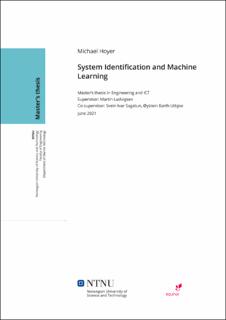| dc.contributor.advisor | Ludvigsen, Martin | |
| dc.contributor.advisor | Sagatun, Svein Ivar | |
| dc.contributor.advisor | Utbjoe, Øystein | |
| dc.contributor.author | Hoyer, Michael | |
| dc.date.accessioned | 2021-10-21T18:09:15Z | |
| dc.date.available | 2021-10-21T18:09:15Z | |
| dc.date.issued | 2021 | |
| dc.identifier | no.ntnu:inspera:78668897:32426735 | |
| dc.identifier.uri | https://hdl.handle.net/11250/2824625 | |
| dc.description.abstract | Simulering har blitt viktigere for utviklingen av roboter på grunn av kostnadsbesparelser og dens avgjørende rolle i valideringen av autonome systemer. Dette øker behovet for billige og presise modeller av robotene som skal simuleres. Mange typer roboter har godt etablerte ligninger som beskriver bevegelsene deres, men de systemavhengige parameterne som disse ligningene er avhengige av velges ofte ved gjetting eller dyre eksperimenter. Ubemannede undervannsroboter (UUV) er en av robottypene dette gjelder for. Disse blir stadig vekk viktigere for undervassoperasjoner, siden gjennombrudd i pris og brukervennlighet har gjort dem aktuelle for flere og flere oppgaver. Denne masteroppgaven er motivert av behovet for bedre metoder til estimering av parametere til bevegelige roboters modeller, og fokuserer på UUVer som testplattform.
I denne mastergraden brukes metoder fra systemidentifikasjon og maskinlæring til å estimere UUV modellparametere basert på simuleringer og målinger av UUVen Beluga. Målingene er samlet ved bruk av interne og eksterne sensorer av høy kvalitet, som sammen dekker alle tilstander i Belugas seks frihetsgrader. Bakgrunnsteori om matematisk modellering av UUVer og systemidentifikasjon presenteres, samt en teknisk gjennomgang av Beluga. Den valgte systemidentifikasjonsmetoden er i stand til å identifisere UUV parametere fra simuleringer i tilfeller med redusert antall frihetsgrader. | |
| dc.description.abstract | Simulation is becoming more important for the development of robots due to cost savings and its key role in validation of autonomous systems. This sparks the need for cheap and accurate models of the robots that are to be simulated. Many classes of moving robots have well established equations that model their movements accurately, but the system specific parameters they depend on are often based on educated guesses or expensive experiments. Unmanned underwater vehicles (UUVs) is one of those classes. Their importance in sub-sea operations only keep growing, as breakthroughs in price and usability make them suitable to more and more applications. The research of this thesis is motivated by the need for better methods to estimate parameters of moving robots models, focusing on UUVs as example platform.
In this thesis techniques from system identification and machine learning are used to estimate UUV model parameters based on simulations and measurements of the Beluga UUV. The measurements are gathered using internal and external sensors of high quality, covering pose and velocity in all six degrees of freedom. Background theory on UUV modelling and system identification is presented, as well as a technical overview of Beluga UUV. The chosen method is able to identify the UUV parameters from simulations in reduced dimensionality cases. | |
| dc.language | eng | |
| dc.publisher | NTNU | |
| dc.title | System Identification and Machine Learning | |
| dc.type | Master thesis | |
